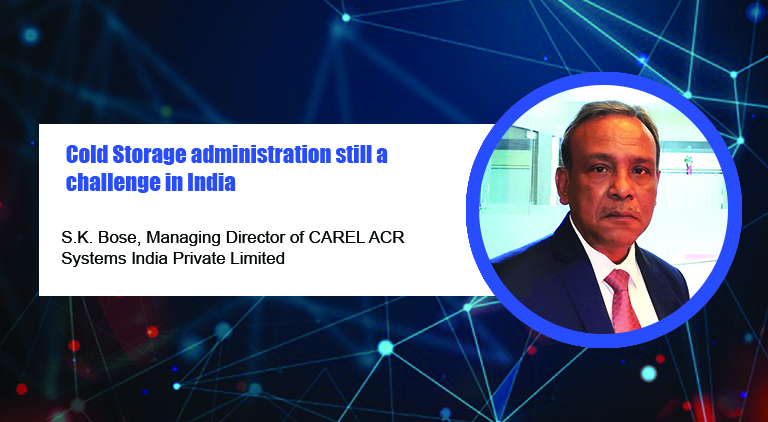Talking about the opportunities for cold chain sector in India, S.K. Bose, Managing Director of CAREL ACR Systems India Private Limited, tells us about the challenges being faced by the industry in terms of temperature-controlled storage and administration towards the same especially in a vast populated country like India.
How are the present global trends impacting the cold chain logistics business?
The cold chain logistic business is growing rapidly globally. The cold chain, a system that helps maintain a desired low-temperature range during transport or storage, is essential in the food business. In recent years, cold chain demand has also been growing in the pharmaceutical and biotechnology industries.
The drivers for cold chain growth in the food business are:
- Changing life styles of people due to economic development
- Government efforts to reduce food waste
- Increase in e-commerce purchases or e-tailing of food products
- The drivers for cold chain growth in the pharmaceutical business are –
- Emergence of precision medicine breakthroughs – cellular therapies, biomarker testing, and regenerative medicine in the form of stem cells.
- Biologic drugs, including a wide variety of products derived from human, animal, or micro-organisms using biotechnology.
Good Distribution Practices (GDPs) and specifically their insistence on temperature monitoring for all types of pharmaceutical products to ensure better quality assurance and safety for end users. The global cold chain market size was valued at $168 billion in 2018 and is projected to reach $447.5 billion by 2025, growing at a CAGR of 15.1 percent.
How is the industry dealing with the temperature-controlled and multi-commodity storage requirements for the pharma, F&B and farming sectors?
While in economically strong countries, the development of cold logistic chains is seeing large investments, other weaker countries are continuously trying to catch up as their economies grow. In India, the government is providing a major push for cold chain development through various incentives and policies.
Looking at India’s climatic and geographical factors, temperature-controlled vehicles for long haul distribution still represent a challenge. What measures are being taken by the sector to overcome these?
In India, higher temperatures poses a challenge for the transport of TSPs (Temperature Sensitive Products) in which sub-zero temperatures are required to preserve the goods. This challenge is specifically more evident in the pharmaceutical sector. However, logistics companies are putting efforts into overcome this technological challenge.
For food, on the other hand, there are shortages of available numbers of facilities both for storage and transport, i.e. cold stores and temperature-controlled trucks. Moreover, highway construction has been an issue, although there have been large improvements in recent years. These are well recognised gaps and work is being focused on these areas.
With the government’s push to amplify India’s cold chain industry, what kinds of opportunities do you foresee in India to revolutionise the cold chain sector?
For the food segment, opportunities involve cooling equipment for storage and transport, remote connectivity and remote supervision etc. The pharmaceutical segment is a bit more complex, and will see opportunities expand in many directions, such as geolocation, big data, data analysis, tracking and tracing and above all integration. Opportunities in packaging and continuous improvement of this in preserving the quality of all products are also opening up many opportunities. These are a few major areas where there are expected to be plenty of opportunities.
How is the industry planning to meet the vaccine storage and transport challenges in Tier II and Tier III cities?
India meets 50 percent of global demand for the various vaccines! Therefore, it has already proven to have a good amount of expertise available. The government’s decision to go for COVID vaccines that can be stored and transported at positive temperatures has reduced the challenge to a great extent. Combining existing expertise in handling vaccines and selection of vaccines, the challenge can be faced successfully.
Apart from investments and storage, what are the major challenges to be addressed? How is the industry moving ahead with them?
Challenges regarding the technology part of distribution are much lower than the challenges of administration in a country with such a large population. Adequate processes seem to have been put in place to handle the challenge.
How has the pandemic impacted the cold chain sector’s growth?
Equipment manufacturers have seen a spurt in demand for their equipment and this has helped businesses make up for some of the downturn that the pandemic brought in 2020. Medical refrigerators, cold rooms for storage, packaging and cold transport have all seen high growth due to the vaccine distribution drive.
___________________________________________________
Cold chain technologies in india are increasing, but administering the distribution part with such a vast population remains to be challenge in India.
S.K. Bose, Managing Director of CAREL ACR Systems India Private Limited
Cookie Consent
We use cookies to personalize your experience. By continuing to visit this website you agree to our Terms & Conditions, Privacy Policy and Cookie Policy.















